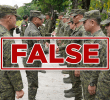DAVAO CITY, Philippines – Forty-nine years ago, thousands of brave Filipino youth fought the dictatorial regime of the late Ferdinand Marcos with a series of mass demonstrations.
The strings of protest that evolved in the early part of 1970 launched the very popular movement among the young generation of that time – the First Quarter Storm or FQS.
From January to March of 1970, thousands of members of FQS organized huge rallies calling for constitutional reforms and the airing of grievances against the administration of Marcos. FQS was instrumental to the conduct of a historical student rally where 500,000 to close to a million youth were gathered in sequences of street demonstrations and rallies in the streets of Manila. Seeing direct threats, the dictatorial regime responded to end the street uprisings with its full military and police might that led to the deaths of some student demonstrators. Scores were also hurt during the violent dispersals to quell the growing activism among the youth. But hundreds still survived and continued their struggle against Marcos.
Today, the bravery of the FQS has become the guiding light and basis of young Filipinos of the millennial generation to continue the struggle and fight for social justice and peace for the country. Filipinos are still confronted by the same issues forty-nine years ago. Many of today’s activists and advocates for genuine change have been into youth activism in different sectoral issues of our society. Like the FQS members in the 70’s, they too are facing formidable challenges and the real and imminent dangers to their lives as they pursue the struggle.
Struggle for Free Education
As young as five years old, student leader and youth activist Beverly Gofredo was already exposed to the world of activism because of her father’s involvement in the worker’s movement. Oftentimes, her father would bring her to union strikes, meetings, consultations, and dialogues.
Her father would always explain to her and her siblings the cause and his involvement with the worker’s organization, as he himself is a worker of a canning industry.
“Oftentimes, my father would bring me to strikes and protests. During intervals and vacant time, he would explain to me the importance of struggle, how the workers are being oppressed by big companies and capitalist. That challenged me to understand more the situation people,” she said.
It was during President Benigno “Noynoy” Aquino’s State of the Nation Address (SONA) that Gofredo was asked to speak in behalf of the youth sector. She was only 12 years of age that time but was already an active member of Anak Bayan High School.
“I was tasked to speak so I made some research and asked my colleagues for references on the current youth situation. There I realized that majority of the Filipino youth do not enjoy the quality of education that is mandated under the constitution. It supposed to be free but it’s not,” she uttered.
At present, Gofredo is the secretary general of the Liga ng mga Iskolar nga Bayan, an organization of lumad and peasant scholars. She is active in their campaign to spare the indigenous people’s alternative schools from attacks by state forces. She has joined a number of protest rallies in different venues in Mindanao and Manila. Outside the rallies, she is active in campaigns and dialogues to ensure that the voices of the youth are heard.
“The quality of education for the Filipino youth has long been a battle cry. Through generations, the struggle continues given that the system of education in the country has become a privilege for those who have the capacity to pay and not a right to everyone,” Gofredo emphasized.
She pointed out that “it is high time to strengthen and awaken” the spirit of activism among the millennial generation to continue to struggle and fight for education.
“Nobody will do it for us,” she continued, adding that “we are young and strong, most of all we own our generation.”
Struggle for Ancestral Land
The Indigenous People’s struggle in the country has always been a big issue. The historical background of the lumad struggle started when capitalists and their big companies forcefully encroached into their ancestral lands for logging and mining concessions. Alongside the widespread logging and mining was the entry of huge projects such as dams and other construction activities. Vast areas of ancestral lands were also subjected to huge plantations of banana, palm oil, papaya, pineapple, and other high-value crops.
As massive capital poured in and the construction activities intensified in ancestral lands, suppression and attacks against lumad leaders who stood up to protect their people and communities ensued that resulted to evacuations, arrests, and killings.
Faced against grueling and incomprehensible situations in their communities, lumad leaders were forced to wage war to defend their families, identities and ancestral lands.
Among the young lumad leaders who continue to carry the struggle is Jong Monzon, the spokesperson of the Pasaka Lumad Confederation of Southern Mindanao.
Back in 2009, his father, who is also the staunch leader of Nagkahiusang mga Mag-uuma sa Boston Davao Oriental and a council member of Pasaka was gunned down by unidentified men. The killing of Monzon’s father was related to his involvement in the peasant and lumad struggle.
“Because of my eagerness to find justice for my father’s death, I was exposed to the communities of lumads and farmers. I saw and experienced their difficult situation and the only way to be heard is to struggle” said Monzon.
He has been active into IP-peasant activism from 2015 and since then became a staunch leader of lumads in Mindanao in expressing their grievances against the continuing attacks in their ancestral lands and abodes.
“The suffering of my tribe is never-ending. History tells us that we, the young generations should lead the struggle and protect our ancestral domain” Monzon said.
He pointed out that the suffering of lumads has worsened due to the continuing imposition of martial law in Mindanao.
Martial law resulted in the increase in a number of human rights abuses, among them was the killing of student Obello Bay-ao in 2017.
The reigning military rule facilitated the massive military operations in the countryside that shut down a number of alternative schools under Salugpungan Ta’ tanu Igkanugon Community Learning Center, the encampment of military personnel inside the lumad communities, and cases of forced surrenders.
“The worsening situations in our communities tell us one thing – that it is only right to struggle even if it will also mean our death,” Monzon said.
Struggle for Human Rights
Jay Apiag started his activism as a campus journalist until he became an active human rights advocate and currently serves as the secretary-general of Karapatan in Southern Mindanao.
But Apiag did not confine his activism inside the school campus as his curiosity on the real situation in communities continues to strike his interests. He spent time immersing himself to the communities of farmers in the province of North Cotabato. The immersions turned out to be real lessons and teaching that portrayed the real situation of the people, especially the voiceless and marginalized sector of peasants and farmers.
“I am young then but being one with the farmers opened my eyes in reality that many of them were oppressed and their rights were disregarded,” said Apiag.
As a young human rights advocate, Apiag has already faced lots of challenges. He and his team of human rights advocates are constantly at the forefront of defending the victims of abuses in the region. And most of these victims are peasants and lumads. Appropriate provisions of assistance to the lumad people and the peasants would require actual immersions in their lands and communities. Apiag said he experienced long hours of walk, crossing rivers, and climbing mountains just to reach communities and provide support to the victims of human rights violations, by documenting their horrible stories and experiences from the hands of their perpetrators who usually turn out as members of state forces.
Recently, a cased was filed against Apiag branding him of having links with the communist movement. Apiag argued he is just helping and facilitating support to the victims of human rights abuses and their families. He has gone through a number of harassments and threats as he continues to advance the rights of the people.
“The sacrifices are all worth it. Though it’s difficult, I think young blood should open their eyes to the reality that these days are doomed days. Our constitutional rights are being attacked and we can’t just sit there and watch people die. We need to struggle and fight,” Apiag pointed out.
Activism among students and the youth started way back in the 70s and in the succeeding years when they realized that struggle is the only way to end Marcos’ dictatorship and oppression. The spirit of activism did not die but continue to live on as new breeds of young activists today believe that the struggle must continue. Activism among youth must continue to fire up. Today’s realities are not different from the past administrations and the oppressive system they implement to govern the people. This must continue to fuel the passion of the Filipino youth in the struggle for change and the end the sufferings and injustices.
“Forty-nine years ago, the Filipino youth united for change. This is the challenge for us today,” Apiag concluded. (davaotoday.com)










